Impact of Globalisation on Tesco's Marketing Strategies Analysis
VerifiedAdded on 2020/10/05
|22
|2646
|490
Report
AI Summary
This report is a research project that investigates the impact of globalisation on the marketing functions of multinational organizations, with a specific focus on Tesco. The introduction outlines the project's nature, aims, objectives, rationale, and a detailed timeline of activities. The literature review provides a theoretical background, while the methodology section describes the research approaches and techniques used, including questionnaires for data collection. The data analysis section presents findings on the benefits of globalisation for Tesco, including technological advancements and communication, as well as the challenges such as cultural complexities and language barriers. The conclusion summarizes the key findings, and the recommendations suggest strategies like alternative marketing, diversity in the workplace and partnerships. A personal reflective statement details the research methods and areas for further exploration. The report provides a comprehensive analysis of how globalisation influences Tesco's marketing strategies and offers practical recommendations for the company.
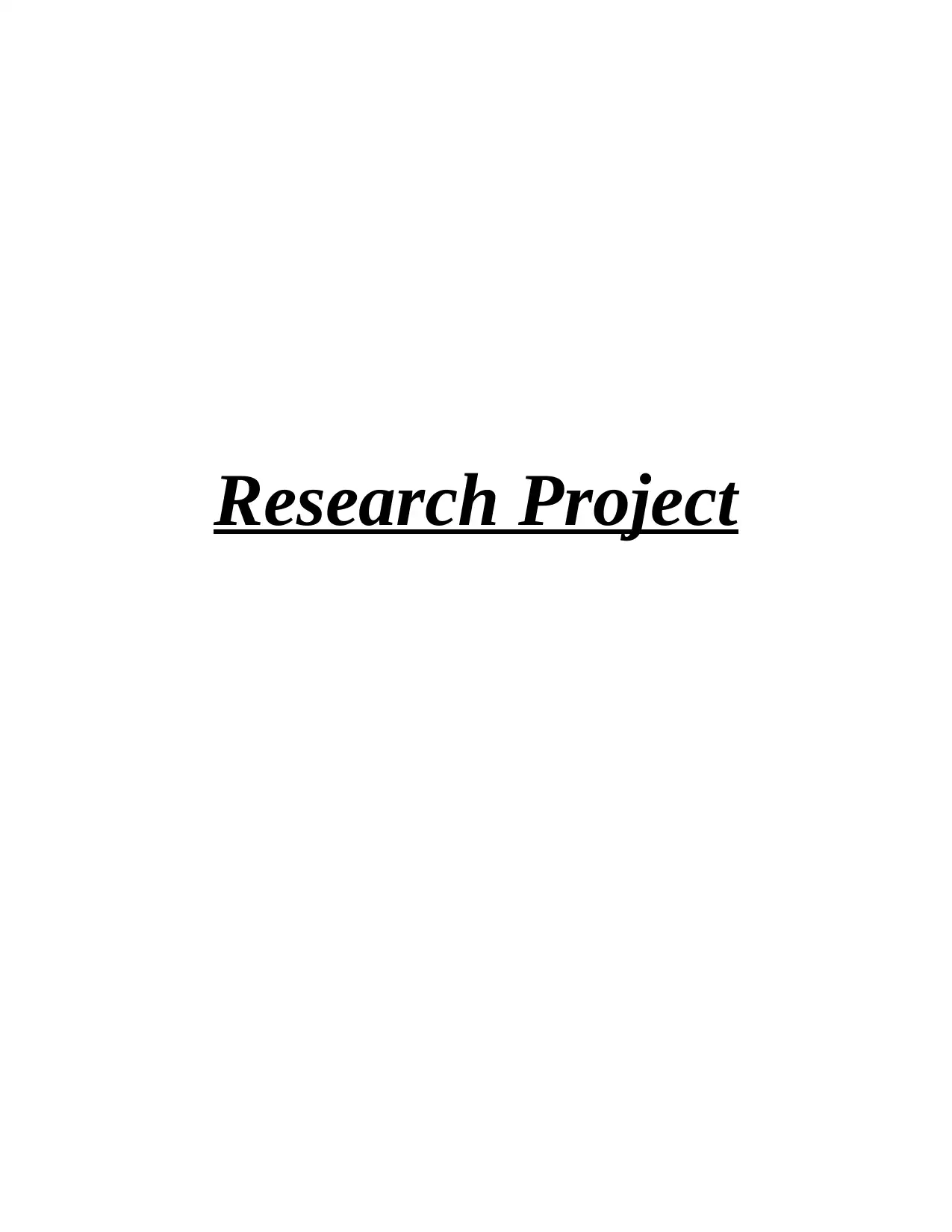
Research Project
Paraphrase This Document
Need a fresh take? Get an instant paraphrase of this document with our AI Paraphraser
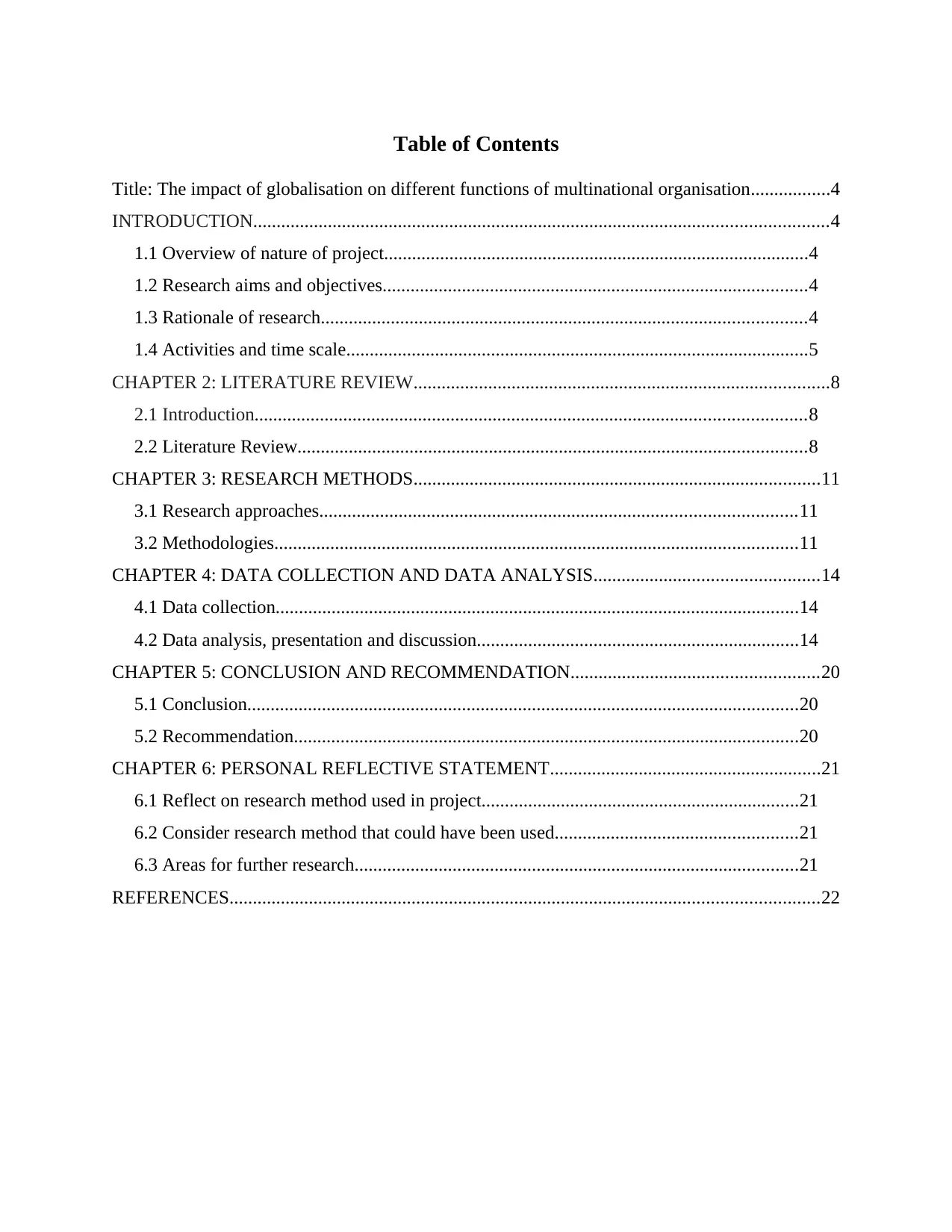
Table of Contents
Title: The impact of globalisation on different functions of multinational organisation.................4
INTRODUCTION...........................................................................................................................4
1.1 Overview of nature of project...........................................................................................4
1.2 Research aims and objectives...........................................................................................4
1.3 Rationale of research........................................................................................................4
1.4 Activities and time scale...................................................................................................5
CHAPTER 2: LITERATURE REVIEW.........................................................................................8
2.1 Introduction......................................................................................................................8
2.2 Literature Review.............................................................................................................8
CHAPTER 3: RESEARCH METHODS.......................................................................................11
3.1 Research approaches......................................................................................................11
3.2 Methodologies................................................................................................................11
CHAPTER 4: DATA COLLECTION AND DATA ANALYSIS................................................14
4.1 Data collection................................................................................................................14
4.2 Data analysis, presentation and discussion.....................................................................14
CHAPTER 5: CONCLUSION AND RECOMMENDATION.....................................................20
5.1 Conclusion......................................................................................................................20
5.2 Recommendation............................................................................................................20
CHAPTER 6: PERSONAL REFLECTIVE STATEMENT..........................................................21
6.1 Reflect on research method used in project....................................................................21
6.2 Consider research method that could have been used....................................................21
6.3 Areas for further research...............................................................................................21
REFERENCES..............................................................................................................................22
Title: The impact of globalisation on different functions of multinational organisation.................4
INTRODUCTION...........................................................................................................................4
1.1 Overview of nature of project...........................................................................................4
1.2 Research aims and objectives...........................................................................................4
1.3 Rationale of research........................................................................................................4
1.4 Activities and time scale...................................................................................................5
CHAPTER 2: LITERATURE REVIEW.........................................................................................8
2.1 Introduction......................................................................................................................8
2.2 Literature Review.............................................................................................................8
CHAPTER 3: RESEARCH METHODS.......................................................................................11
3.1 Research approaches......................................................................................................11
3.2 Methodologies................................................................................................................11
CHAPTER 4: DATA COLLECTION AND DATA ANALYSIS................................................14
4.1 Data collection................................................................................................................14
4.2 Data analysis, presentation and discussion.....................................................................14
CHAPTER 5: CONCLUSION AND RECOMMENDATION.....................................................20
5.1 Conclusion......................................................................................................................20
5.2 Recommendation............................................................................................................20
CHAPTER 6: PERSONAL REFLECTIVE STATEMENT..........................................................21
6.1 Reflect on research method used in project....................................................................21
6.2 Consider research method that could have been used....................................................21
6.3 Areas for further research...............................................................................................21
REFERENCES..............................................................................................................................22

⊘ This is a preview!⊘
Do you want full access?
Subscribe today to unlock all pages.

Trusted by 1+ million students worldwide
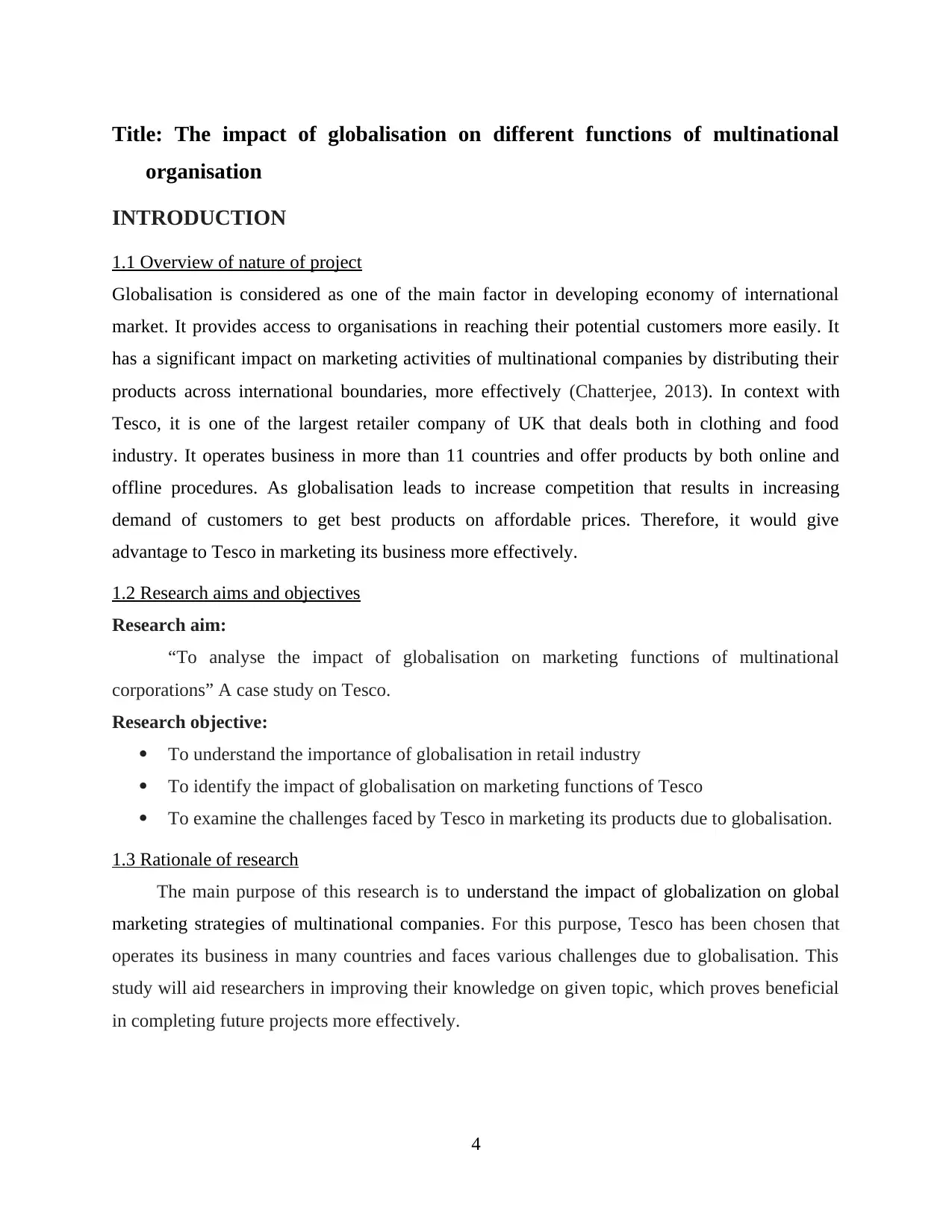
Title: The impact of globalisation on different functions of multinational
organisation
INTRODUCTION
1.1 Overview of nature of project
Globalisation is considered as one of the main factor in developing economy of international
market. It provides access to organisations in reaching their potential customers more easily. It
has a significant impact on marketing activities of multinational companies by distributing their
products across international boundaries, more effectively (Chatterjee, 2013). In context with
Tesco, it is one of the largest retailer company of UK that deals both in clothing and food
industry. It operates business in more than 11 countries and offer products by both online and
offline procedures. As globalisation leads to increase competition that results in increasing
demand of customers to get best products on affordable prices. Therefore, it would give
advantage to Tesco in marketing its business more effectively.
1.2 Research aims and objectives
Research aim:
“To analyse the impact of globalisation on marketing functions of multinational
corporations” A case study on Tesco.
Research objective:
To understand the importance of globalisation in retail industry
To identify the impact of globalisation on marketing functions of Tesco
To examine the challenges faced by Tesco in marketing its products due to globalisation.
1.3 Rationale of research
The main purpose of this research is to understand the impact of globalization on global
marketing strategies of multinational companies. For this purpose, Tesco has been chosen that
operates its business in many countries and faces various challenges due to globalisation. This
study will aid researchers in improving their knowledge on given topic, which proves beneficial
in completing future projects more effectively.
4
organisation
INTRODUCTION
1.1 Overview of nature of project
Globalisation is considered as one of the main factor in developing economy of international
market. It provides access to organisations in reaching their potential customers more easily. It
has a significant impact on marketing activities of multinational companies by distributing their
products across international boundaries, more effectively (Chatterjee, 2013). In context with
Tesco, it is one of the largest retailer company of UK that deals both in clothing and food
industry. It operates business in more than 11 countries and offer products by both online and
offline procedures. As globalisation leads to increase competition that results in increasing
demand of customers to get best products on affordable prices. Therefore, it would give
advantage to Tesco in marketing its business more effectively.
1.2 Research aims and objectives
Research aim:
“To analyse the impact of globalisation on marketing functions of multinational
corporations” A case study on Tesco.
Research objective:
To understand the importance of globalisation in retail industry
To identify the impact of globalisation on marketing functions of Tesco
To examine the challenges faced by Tesco in marketing its products due to globalisation.
1.3 Rationale of research
The main purpose of this research is to understand the impact of globalization on global
marketing strategies of multinational companies. For this purpose, Tesco has been chosen that
operates its business in many countries and faces various challenges due to globalisation. This
study will aid researchers in improving their knowledge on given topic, which proves beneficial
in completing future projects more effectively.
4
Paraphrase This Document
Need a fresh take? Get an instant paraphrase of this document with our AI Paraphraser
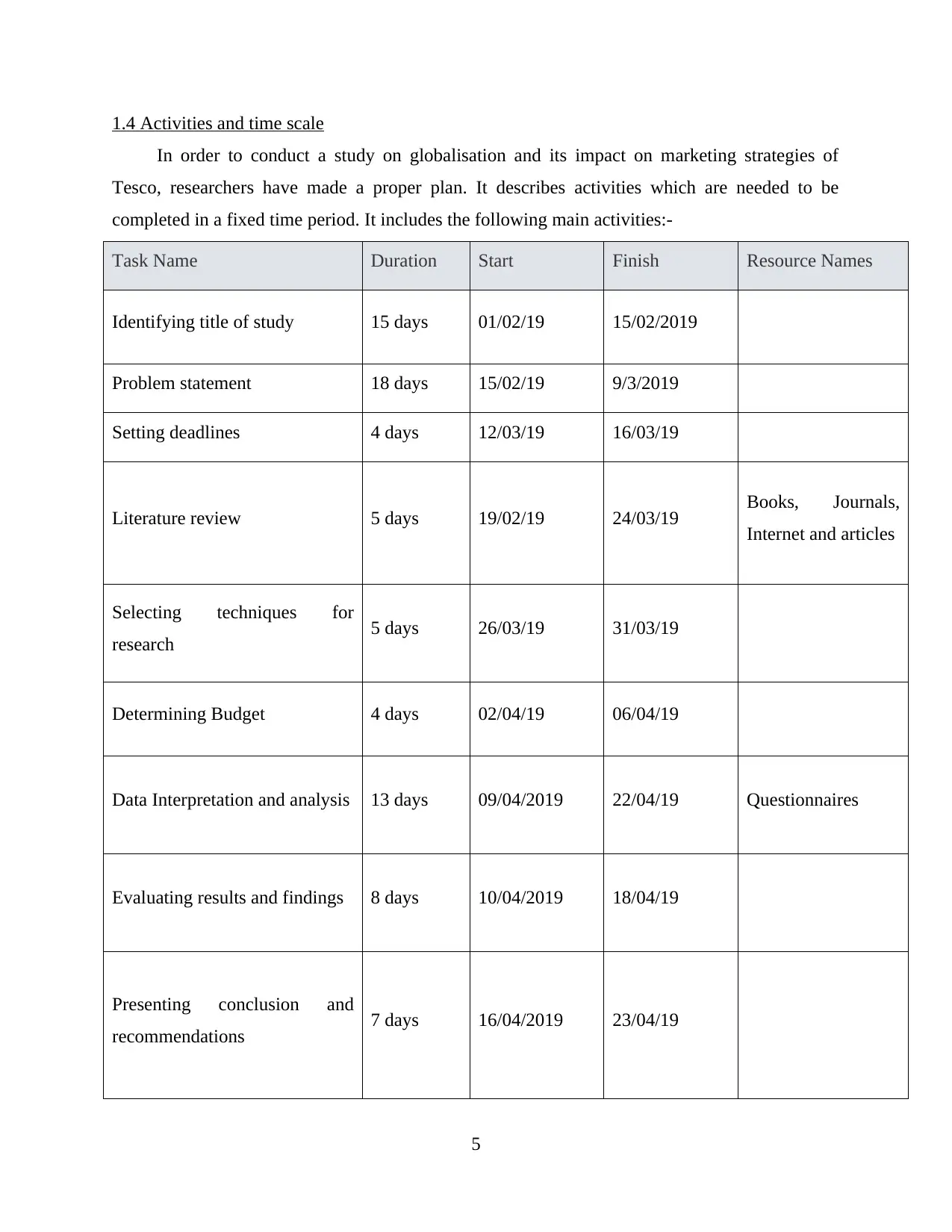
1.4 Activities and time scale
In order to conduct a study on globalisation and its impact on marketing strategies of
Tesco, researchers have made a proper plan. It describes activities which are needed to be
completed in a fixed time period. It includes the following main activities:-
Task Name Duration Start Finish Resource Names
Identifying title of study 15 days 01/02/19 15/02/2019
Problem statement 18 days 15/02/19 9/3/2019
Setting deadlines 4 days 12/03/19 16/03/19
Literature review 5 days 19/02/19 24/03/19 Books, Journals,
Internet and articles
Selecting techniques for
research 5 days 26/03/19 31/03/19
Determining Budget 4 days 02/04/19 06/04/19
Data Interpretation and analysis 13 days 09/04/2019 22/04/19 Questionnaires
Evaluating results and findings 8 days 10/04/2019 18/04/19
Presenting conclusion and
recommendations 7 days 16/04/2019 23/04/19
5
In order to conduct a study on globalisation and its impact on marketing strategies of
Tesco, researchers have made a proper plan. It describes activities which are needed to be
completed in a fixed time period. It includes the following main activities:-
Task Name Duration Start Finish Resource Names
Identifying title of study 15 days 01/02/19 15/02/2019
Problem statement 18 days 15/02/19 9/3/2019
Setting deadlines 4 days 12/03/19 16/03/19
Literature review 5 days 19/02/19 24/03/19 Books, Journals,
Internet and articles
Selecting techniques for
research 5 days 26/03/19 31/03/19
Determining Budget 4 days 02/04/19 06/04/19
Data Interpretation and analysis 13 days 09/04/2019 22/04/19 Questionnaires
Evaluating results and findings 8 days 10/04/2019 18/04/19
Presenting conclusion and
recommendations 7 days 16/04/2019 23/04/19
5
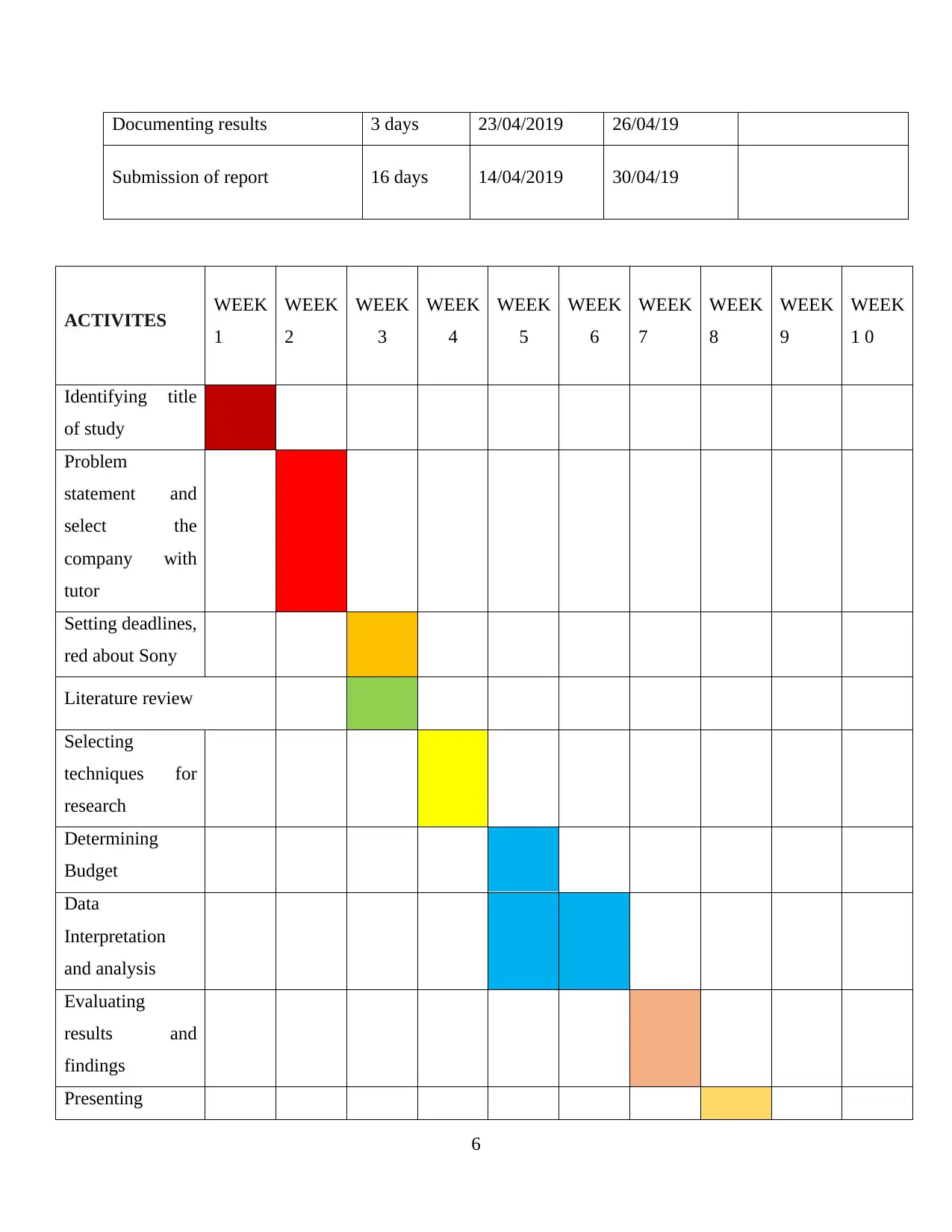
Documenting results 3 days 23/04/2019 26/04/19
Submission of report 16 days 14/04/2019 30/04/19
ACTIVITES WEEK
1
WEEK
2
WEEK
3
WEEK
4
WEEK
5
WEEK
6
WEEK
7
WEEK
8
WEEK
9
WEEK
1 0
Identifying title
of study
Problem
statement and
select the
company with
tutor
Setting deadlines,
red about Sony
Literature review
Selecting
techniques for
research
Determining
Budget
Data
Interpretation
and analysis
Evaluating
results and
findings
Presenting
6
Submission of report 16 days 14/04/2019 30/04/19
ACTIVITES WEEK
1
WEEK
2
WEEK
3
WEEK
4
WEEK
5
WEEK
6
WEEK
7
WEEK
8
WEEK
9
WEEK
1 0
Identifying title
of study
Problem
statement and
select the
company with
tutor
Setting deadlines,
red about Sony
Literature review
Selecting
techniques for
research
Determining
Budget
Data
Interpretation
and analysis
Evaluating
results and
findings
Presenting
6
⊘ This is a preview!⊘
Do you want full access?
Subscribe today to unlock all pages.

Trusted by 1+ million students worldwide
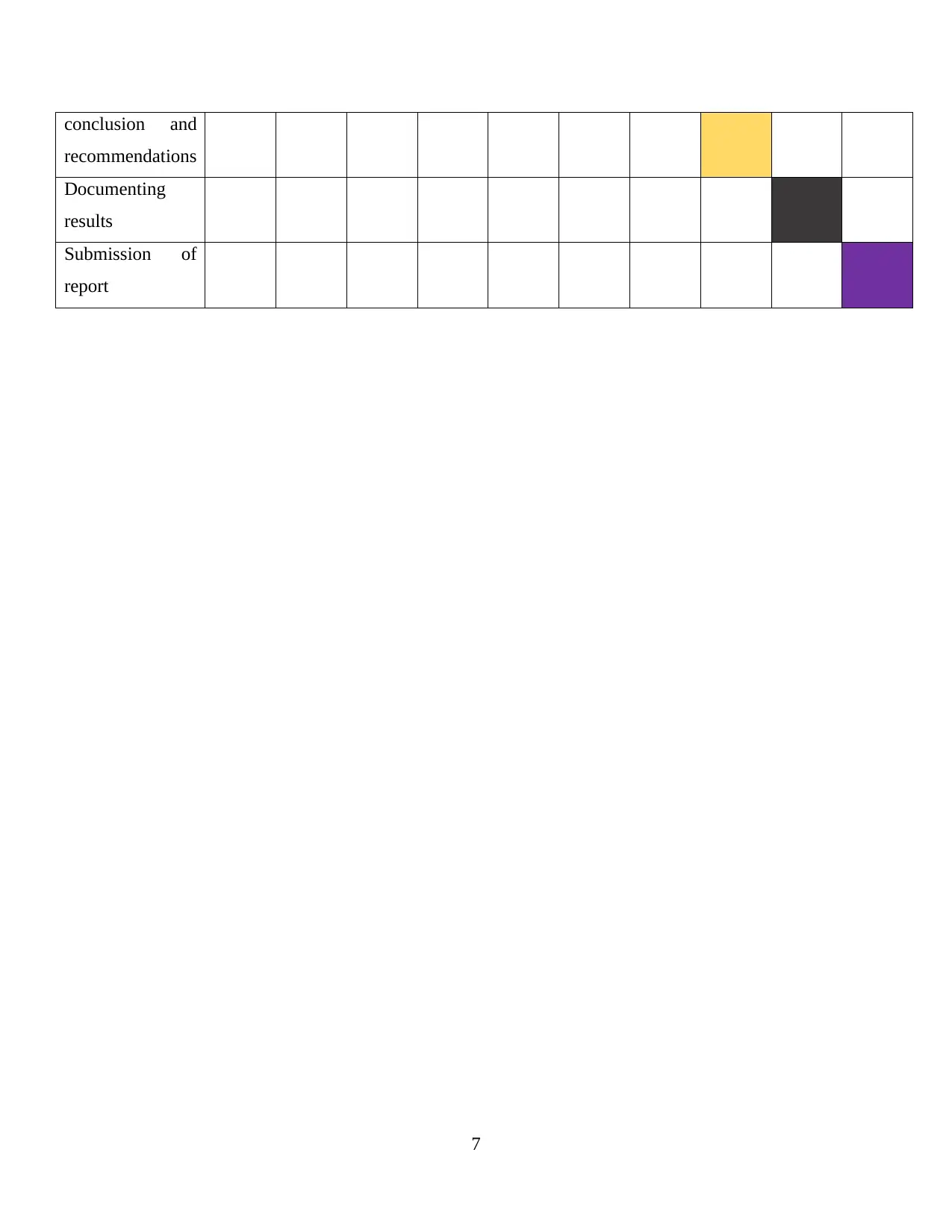
conclusion and
recommendations
Documenting
results
Submission of
report
7
recommendations
Documenting
results
Submission of
report
7
Paraphrase This Document
Need a fresh take? Get an instant paraphrase of this document with our AI Paraphraser
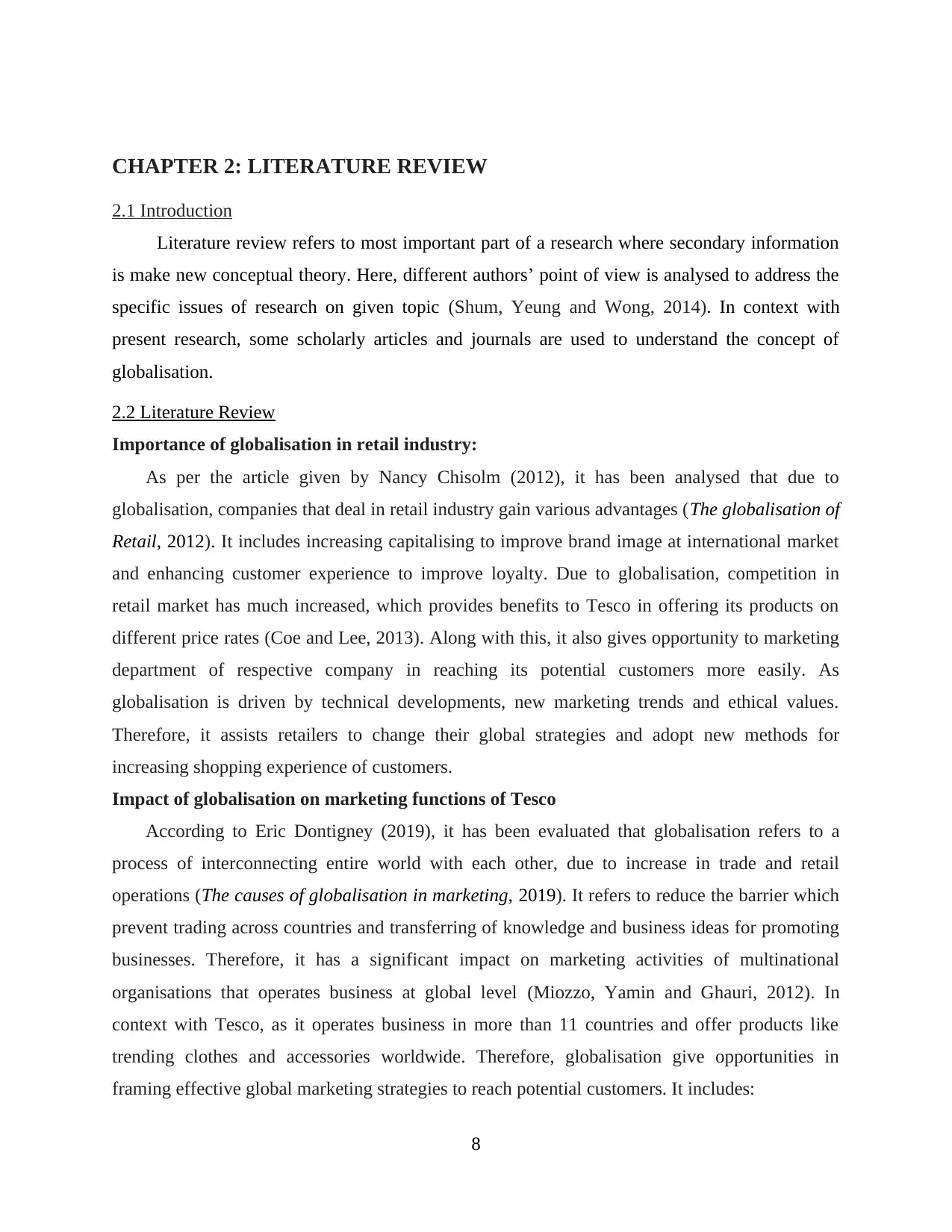
CHAPTER 2: LITERATURE REVIEW
2.1 Introduction
Literature review refers to most important part of a research where secondary information
is make new conceptual theory. Here, different authors’ point of view is analysed to address the
specific issues of research on given topic (Shum, Yeung and Wong, 2014). In context with
present research, some scholarly articles and journals are used to understand the concept of
globalisation.
2.2 Literature Review
Importance of globalisation in retail industry:
As per the article given by Nancy Chisolm (2012), it has been analysed that due to
globalisation, companies that deal in retail industry gain various advantages (The globalisation of
Retail, 2012). It includes increasing capitalising to improve brand image at international market
and enhancing customer experience to improve loyalty. Due to globalisation, competition in
retail market has much increased, which provides benefits to Tesco in offering its products on
different price rates (Coe and Lee, 2013). Along with this, it also gives opportunity to marketing
department of respective company in reaching its potential customers more easily. As
globalisation is driven by technical developments, new marketing trends and ethical values.
Therefore, it assists retailers to change their global strategies and adopt new methods for
increasing shopping experience of customers.
Impact of globalisation on marketing functions of Tesco
According to Eric Dontigney (2019), it has been evaluated that globalisation refers to a
process of interconnecting entire world with each other, due to increase in trade and retail
operations (The causes of globalisation in marketing, 2019). It refers to reduce the barrier which
prevent trading across countries and transferring of knowledge and business ideas for promoting
businesses. Therefore, it has a significant impact on marketing activities of multinational
organisations that operates business at global level (Miozzo, Yamin and Ghauri, 2012). In
context with Tesco, as it operates business in more than 11 countries and offer products like
trending clothes and accessories worldwide. Therefore, globalisation give opportunities in
framing effective global marketing strategies to reach potential customers. It includes:
8
2.1 Introduction
Literature review refers to most important part of a research where secondary information
is make new conceptual theory. Here, different authors’ point of view is analysed to address the
specific issues of research on given topic (Shum, Yeung and Wong, 2014). In context with
present research, some scholarly articles and journals are used to understand the concept of
globalisation.
2.2 Literature Review
Importance of globalisation in retail industry:
As per the article given by Nancy Chisolm (2012), it has been analysed that due to
globalisation, companies that deal in retail industry gain various advantages (The globalisation of
Retail, 2012). It includes increasing capitalising to improve brand image at international market
and enhancing customer experience to improve loyalty. Due to globalisation, competition in
retail market has much increased, which provides benefits to Tesco in offering its products on
different price rates (Coe and Lee, 2013). Along with this, it also gives opportunity to marketing
department of respective company in reaching its potential customers more easily. As
globalisation is driven by technical developments, new marketing trends and ethical values.
Therefore, it assists retailers to change their global strategies and adopt new methods for
increasing shopping experience of customers.
Impact of globalisation on marketing functions of Tesco
According to Eric Dontigney (2019), it has been evaluated that globalisation refers to a
process of interconnecting entire world with each other, due to increase in trade and retail
operations (The causes of globalisation in marketing, 2019). It refers to reduce the barrier which
prevent trading across countries and transferring of knowledge and business ideas for promoting
businesses. Therefore, it has a significant impact on marketing activities of multinational
organisations that operates business at global level (Miozzo, Yamin and Ghauri, 2012). In
context with Tesco, as it operates business in more than 11 countries and offer products like
trending clothes and accessories worldwide. Therefore, globalisation give opportunities in
framing effective global marketing strategies to reach potential customers. It includes:
8
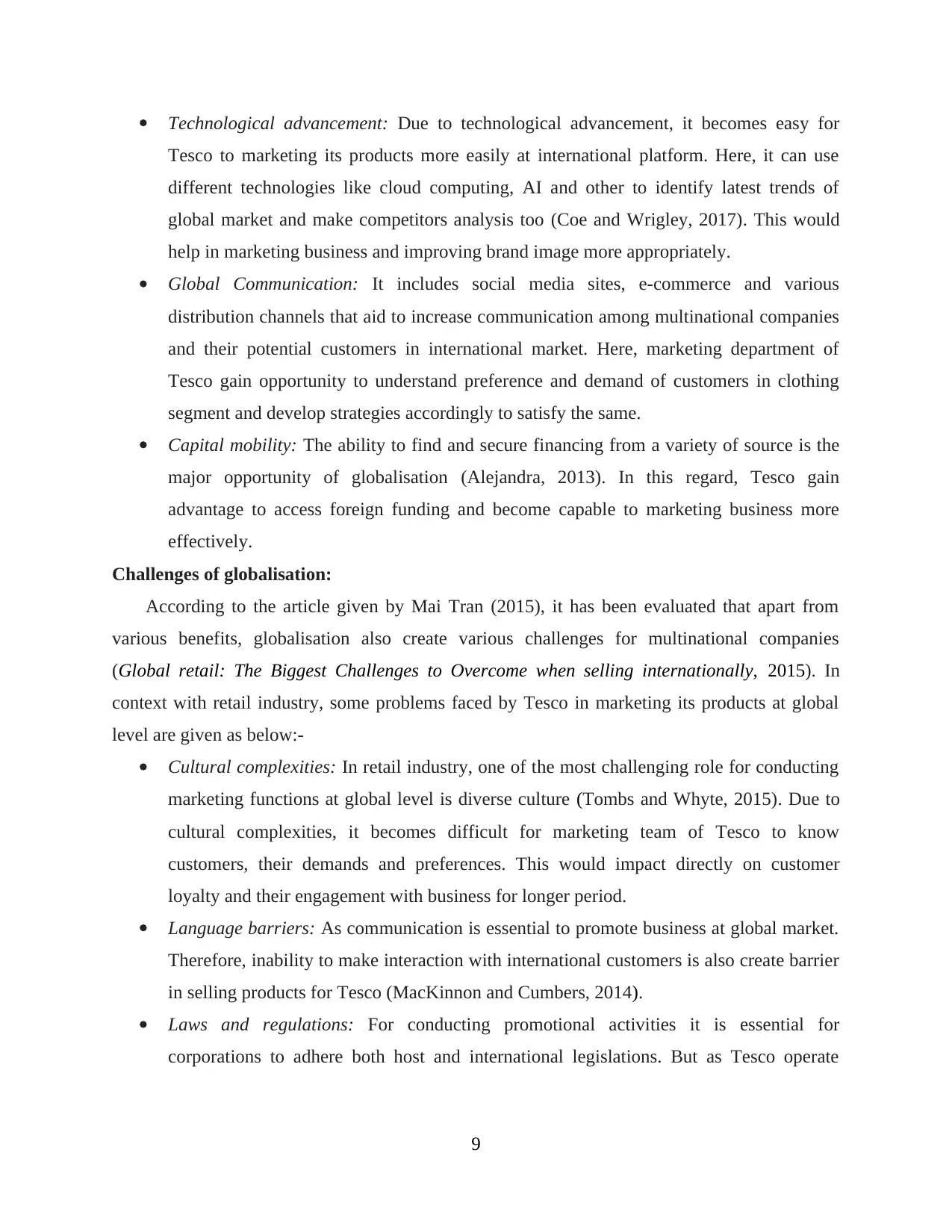
Technological advancement: Due to technological advancement, it becomes easy for
Tesco to marketing its products more easily at international platform. Here, it can use
different technologies like cloud computing, AI and other to identify latest trends of
global market and make competitors analysis too (Coe and Wrigley, 2017). This would
help in marketing business and improving brand image more appropriately.
Global Communication: It includes social media sites, e-commerce and various
distribution channels that aid to increase communication among multinational companies
and their potential customers in international market. Here, marketing department of
Tesco gain opportunity to understand preference and demand of customers in clothing
segment and develop strategies accordingly to satisfy the same.
Capital mobility: The ability to find and secure financing from a variety of source is the
major opportunity of globalisation (Alejandra, 2013). In this regard, Tesco gain
advantage to access foreign funding and become capable to marketing business more
effectively.
Challenges of globalisation:
According to the article given by Mai Tran (2015), it has been evaluated that apart from
various benefits, globalisation also create various challenges for multinational companies
(Global retail: The Biggest Challenges to Overcome when selling internationally, 2015). In
context with retail industry, some problems faced by Tesco in marketing its products at global
level are given as below:-
Cultural complexities: In retail industry, one of the most challenging role for conducting
marketing functions at global level is diverse culture (Tombs and Whyte, 2015). Due to
cultural complexities, it becomes difficult for marketing team of Tesco to know
customers, their demands and preferences. This would impact directly on customer
loyalty and their engagement with business for longer period.
Language barriers: As communication is essential to promote business at global market.
Therefore, inability to make interaction with international customers is also create barrier
in selling products for Tesco (MacKinnon and Cumbers, 2014).
Laws and regulations: For conducting promotional activities it is essential for
corporations to adhere both host and international legislations. But as Tesco operate
9
Tesco to marketing its products more easily at international platform. Here, it can use
different technologies like cloud computing, AI and other to identify latest trends of
global market and make competitors analysis too (Coe and Wrigley, 2017). This would
help in marketing business and improving brand image more appropriately.
Global Communication: It includes social media sites, e-commerce and various
distribution channels that aid to increase communication among multinational companies
and their potential customers in international market. Here, marketing department of
Tesco gain opportunity to understand preference and demand of customers in clothing
segment and develop strategies accordingly to satisfy the same.
Capital mobility: The ability to find and secure financing from a variety of source is the
major opportunity of globalisation (Alejandra, 2013). In this regard, Tesco gain
advantage to access foreign funding and become capable to marketing business more
effectively.
Challenges of globalisation:
According to the article given by Mai Tran (2015), it has been evaluated that apart from
various benefits, globalisation also create various challenges for multinational companies
(Global retail: The Biggest Challenges to Overcome when selling internationally, 2015). In
context with retail industry, some problems faced by Tesco in marketing its products at global
level are given as below:-
Cultural complexities: In retail industry, one of the most challenging role for conducting
marketing functions at global level is diverse culture (Tombs and Whyte, 2015). Due to
cultural complexities, it becomes difficult for marketing team of Tesco to know
customers, their demands and preferences. This would impact directly on customer
loyalty and their engagement with business for longer period.
Language barriers: As communication is essential to promote business at global market.
Therefore, inability to make interaction with international customers is also create barrier
in selling products for Tesco (MacKinnon and Cumbers, 2014).
Laws and regulations: For conducting promotional activities it is essential for
corporations to adhere both host and international legislations. But as Tesco operate
9
⊘ This is a preview!⊘
Do you want full access?
Subscribe today to unlock all pages.

Trusted by 1+ million students worldwide

business in many countries therefore, adherence of laws of all nations seems to be much
difficult.
10
difficult.
10
Paraphrase This Document
Need a fresh take? Get an instant paraphrase of this document with our AI Paraphraser
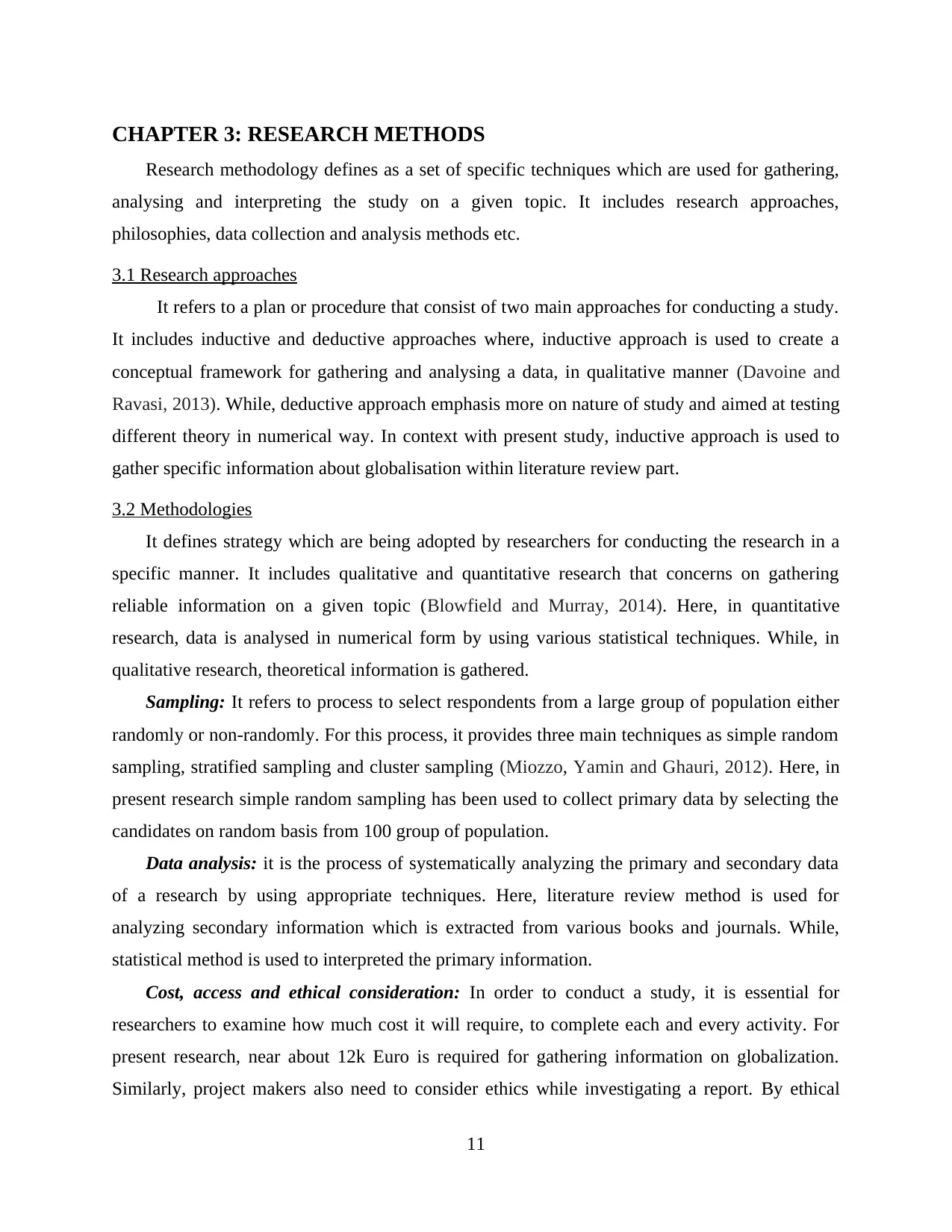
CHAPTER 3: RESEARCH METHODS
Research methodology defines as a set of specific techniques which are used for gathering,
analysing and interpreting the study on a given topic. It includes research approaches,
philosophies, data collection and analysis methods etc.
3.1 Research approaches
It refers to a plan or procedure that consist of two main approaches for conducting a study.
It includes inductive and deductive approaches where, inductive approach is used to create a
conceptual framework for gathering and analysing a data, in qualitative manner (Davoine and
Ravasi, 2013). While, deductive approach emphasis more on nature of study and aimed at testing
different theory in numerical way. In context with present study, inductive approach is used to
gather specific information about globalisation within literature review part.
3.2 Methodologies
It defines strategy which are being adopted by researchers for conducting the research in a
specific manner. It includes qualitative and quantitative research that concerns on gathering
reliable information on a given topic (Blowfield and Murray, 2014). Here, in quantitative
research, data is analysed in numerical form by using various statistical techniques. While, in
qualitative research, theoretical information is gathered.
Sampling: It refers to process to select respondents from a large group of population either
randomly or non-randomly. For this process, it provides three main techniques as simple random
sampling, stratified sampling and cluster sampling (Miozzo, Yamin and Ghauri, 2012). Here, in
present research simple random sampling has been used to collect primary data by selecting the
candidates on random basis from 100 group of population.
Data analysis: it is the process of systematically analyzing the primary and secondary data
of a research by using appropriate techniques. Here, literature review method is used for
analyzing secondary information which is extracted from various books and journals. While,
statistical method is used to interpreted the primary information.
Cost, access and ethical consideration: In order to conduct a study, it is essential for
researchers to examine how much cost it will require, to complete each and every activity. For
present research, near about 12k Euro is required for gathering information on globalization.
Similarly, project makers also need to consider ethics while investigating a report. By ethical
11
Research methodology defines as a set of specific techniques which are used for gathering,
analysing and interpreting the study on a given topic. It includes research approaches,
philosophies, data collection and analysis methods etc.
3.1 Research approaches
It refers to a plan or procedure that consist of two main approaches for conducting a study.
It includes inductive and deductive approaches where, inductive approach is used to create a
conceptual framework for gathering and analysing a data, in qualitative manner (Davoine and
Ravasi, 2013). While, deductive approach emphasis more on nature of study and aimed at testing
different theory in numerical way. In context with present study, inductive approach is used to
gather specific information about globalisation within literature review part.
3.2 Methodologies
It defines strategy which are being adopted by researchers for conducting the research in a
specific manner. It includes qualitative and quantitative research that concerns on gathering
reliable information on a given topic (Blowfield and Murray, 2014). Here, in quantitative
research, data is analysed in numerical form by using various statistical techniques. While, in
qualitative research, theoretical information is gathered.
Sampling: It refers to process to select respondents from a large group of population either
randomly or non-randomly. For this process, it provides three main techniques as simple random
sampling, stratified sampling and cluster sampling (Miozzo, Yamin and Ghauri, 2012). Here, in
present research simple random sampling has been used to collect primary data by selecting the
candidates on random basis from 100 group of population.
Data analysis: it is the process of systematically analyzing the primary and secondary data
of a research by using appropriate techniques. Here, literature review method is used for
analyzing secondary information which is extracted from various books and journals. While,
statistical method is used to interpreted the primary information.
Cost, access and ethical consideration: In order to conduct a study, it is essential for
researchers to examine how much cost it will require, to complete each and every activity. For
present research, near about 12k Euro is required for gathering information on globalization.
Similarly, project makers also need to consider ethics while investigating a report. By ethical
11
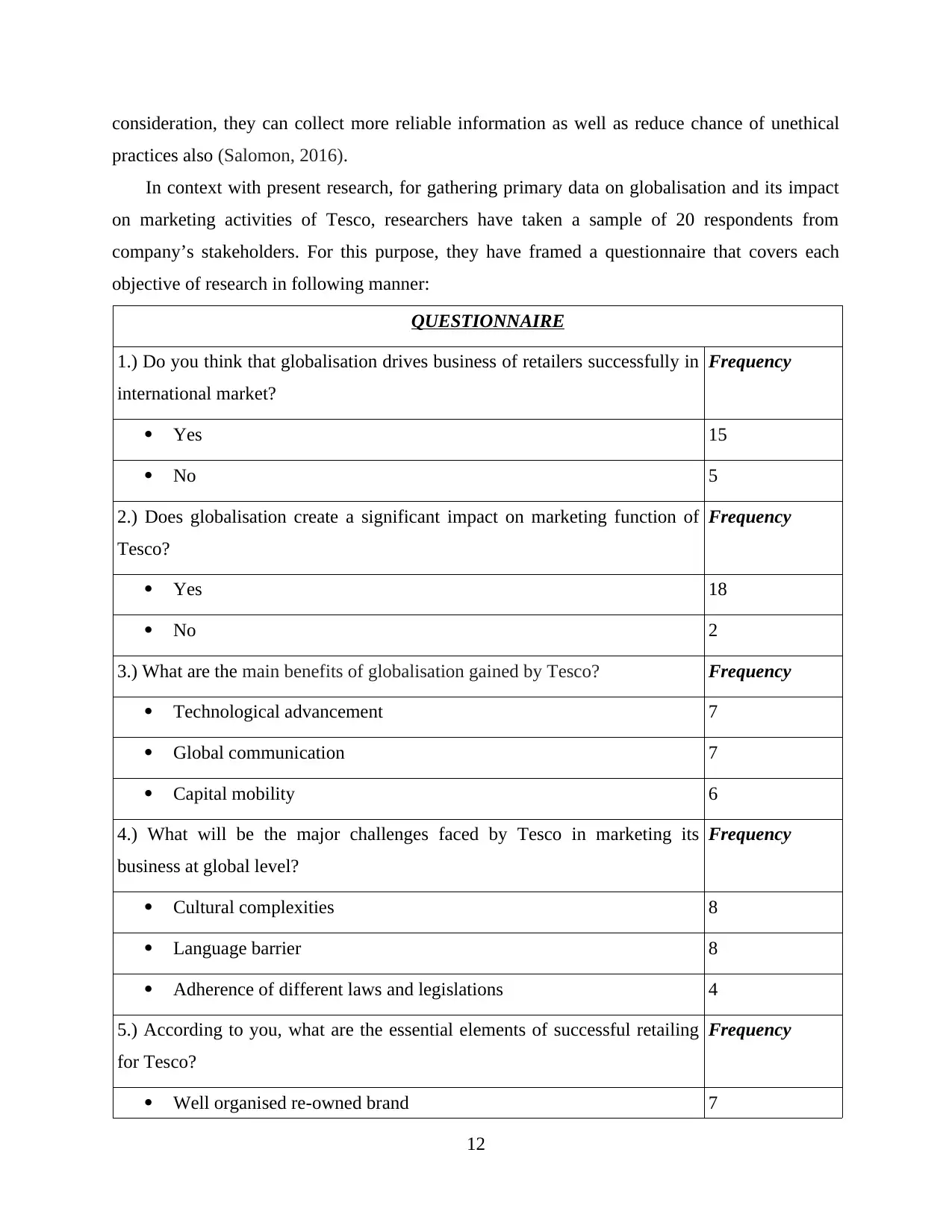
consideration, they can collect more reliable information as well as reduce chance of unethical
practices also (Salomon, 2016).
In context with present research, for gathering primary data on globalisation and its impact
on marketing activities of Tesco, researchers have taken a sample of 20 respondents from
company’s stakeholders. For this purpose, they have framed a questionnaire that covers each
objective of research in following manner:
QUESTIONNAIRE
1.) Do you think that globalisation drives business of retailers successfully in
international market?
Frequency
Yes 15
No 5
2.) Does globalisation create a significant impact on marketing function of
Tesco?
Frequency
Yes 18
No 2
3.) What are the main benefits of globalisation gained by Tesco? Frequency
Technological advancement 7
Global communication 7
Capital mobility 6
4.) What will be the major challenges faced by Tesco in marketing its
business at global level?
Frequency
Cultural complexities 8
Language barrier 8
Adherence of different laws and legislations 4
5.) According to you, what are the essential elements of successful retailing
for Tesco?
Frequency
Well organised re-owned brand 7
12
practices also (Salomon, 2016).
In context with present research, for gathering primary data on globalisation and its impact
on marketing activities of Tesco, researchers have taken a sample of 20 respondents from
company’s stakeholders. For this purpose, they have framed a questionnaire that covers each
objective of research in following manner:
QUESTIONNAIRE
1.) Do you think that globalisation drives business of retailers successfully in
international market?
Frequency
Yes 15
No 5
2.) Does globalisation create a significant impact on marketing function of
Tesco?
Frequency
Yes 18
No 2
3.) What are the main benefits of globalisation gained by Tesco? Frequency
Technological advancement 7
Global communication 7
Capital mobility 6
4.) What will be the major challenges faced by Tesco in marketing its
business at global level?
Frequency
Cultural complexities 8
Language barrier 8
Adherence of different laws and legislations 4
5.) According to you, what are the essential elements of successful retailing
for Tesco?
Frequency
Well organised re-owned brand 7
12
⊘ This is a preview!⊘
Do you want full access?
Subscribe today to unlock all pages.

Trusted by 1+ million students worldwide
1 out of 22
Related Documents
Your All-in-One AI-Powered Toolkit for Academic Success.
+13062052269
info@desklib.com
Available 24*7 on WhatsApp / Email
![[object Object]](/_next/static/media/star-bottom.7253800d.svg)
Unlock your academic potential
Copyright © 2020–2025 A2Z Services. All Rights Reserved. Developed and managed by ZUCOL.





